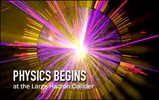Physics Begins At The Large Hadron Collider

Batavia, IL and Upton, NY — The Large Hadron Collider has launched a new era for particle physics. Today at 1:06 p.m. Central European Summer Time (CEST) at CERN in Geneva, Switzerland, the first particles collided at the record energy of seven trillion electron volts (TeV). These collisions mark the start of a decades-long LHC research program, and the beginning of the search for discoveries by thousands of scientists around the world.
"Today's first 7 TeV collisions are a great start for LHC science," said Dr. Dennis Kovar, Associate Director of Science for High Energy Physics at the U.S. Department of Energy. "We eagerly anticipate the work of the world's physicists as they begin their search for dark matter, extra dimensions, and the ever-elusive Higgs boson."
Today's proton collisions were recorded by the LHC experiments' particle detectors, known by their acronyms: ATLAS, CMS, ALICE and LHCb. While the LHC accelerator brings the protons up to their maximum energy and steers them around the 16-mile ring into collision, the experiments use massive particle detectors to record and analyze the collision debris.
"The LHC experiments are the world's largest and most complex scientific instruments, and scientists from American universities and laboratories have made vital contributions to each of them," said Dr. Edward Seidel, Acting Assistant Director of the National Science Foundation's Directorate For Mathematical and Physical Sciences. "We wish all the LHC scientists success in their quest to solve some of the most profound mysteries of our universe."
More than 1,700 scientists, engineers, students and technicians from 89 American universities, seven U.S. Department of Energy (DOE) national laboratories, and one supercomputing center helped design, build and operate the LHC accelerator and its four massive particle detectors. American participation is supported by the DOE's Office of Science and the National Science Foundation (NSF).
Now, the real work begins for the LHC teams. Over the next 18 to 24 months, the LHC accelerator will deliver enough collisions at 7 TeV to enable significant advances in a number of research areas. As data begins to pour from their detectors, more than 8,000 LHC scientists around the world will sift through the flood in search of the tiny signals that could indicate discovery.
"It's a great day to be a particle physicist," said CERN Director General Rolf Heuer. "A lot of people have waited a long time for this moment, but their patience and dedication is starting to pay dividends."
The DOE's Brookhaven National Laboratory and Fermi National Accelerator Laboratory are the host laboratories for the U.S. groups participating in the ATLAS and CMS experiments, respectively. Scientists from American universities and laboratories, who comprise more than 20% of the ATLAS collaboration and 35% of CMS, have played major roles in the construction of both detectors, and join thousands of international colleagues as they operate the detector and analyze the collision data that will be collected in the coming years. In addition, Lawrence Berkeley National Laboratory is the host laboratory for U.S. groups participating in ALICE, with American scientists contributing 10% of the ALICE collaboration.
The United States is also home to major national and regional computing centers that, as part of the Worldwide LHC Computing Grid, enable scientists in the United States and around the world to access the enormous amount of data generated by the LHC experiments. Brookhaven National Laboratory and Fermi National Accelerator Laboratory, host to major "Tier-1" computing centers, are the first stop in the U.S. for data from the ATLAS and CMS experiments, respectively. The data are further distributed to smaller NSF and DOE-funded "Tier-2" and "Tier-3" computing centers across the country, where physicists will conduct the analyses that may lead to LHC discoveries.
SOURCE: Brookhaven National Laboratory
